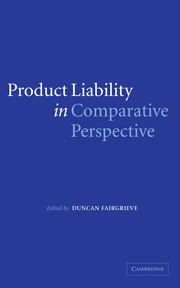Book contents
- Frontmatter
- Contents
- List of figures
- Foreword by Sir Michael Burton
- List of contributors
- Preface
- 1 Introduction
- PART I Country reports
- 2 The use of comparative law in A & Others v National Blood Authority
- 3 Spanish product liability today – adapting to the ‘new’ rules
- 4 Interaction between the European Directive on Product Liability and the former liability regime in Italy
- 5 L'Exception française? The French law of product liability
- 6 German product liability law: between European Directives, American Restatements and common sense
- 7 Dutch case law on the EU Product Liability Directive
- 8 Defect in English law – lessons for the harmonisation of European product liability
- PART II European influences
- PART III Comparing systems
- Appendix
- Index
8 - Defect in English law – lessons for the harmonisation of European product liability
from PART I - Country reports
Published online by Cambridge University Press: 28 July 2009
- Frontmatter
- Contents
- List of figures
- Foreword by Sir Michael Burton
- List of contributors
- Preface
- 1 Introduction
- PART I Country reports
- 2 The use of comparative law in A & Others v National Blood Authority
- 3 Spanish product liability today – adapting to the ‘new’ rules
- 4 Interaction between the European Directive on Product Liability and the former liability regime in Italy
- 5 L'Exception française? The French law of product liability
- 6 German product liability law: between European Directives, American Restatements and common sense
- 7 Dutch case law on the EU Product Liability Directive
- 8 Defect in English law – lessons for the harmonisation of European product liability
- PART II European influences
- PART III Comparing systems
- Appendix
- Index
Summary
Comparative law in the courtroom
Comparative law has figured prominently in recent high profile English tort cases; none more so than in the judgment of Mr Justice Burton in A v National Blood Authority. This was particularly striking for it was a first instance decision and might signify that comparative law in the future will not be the sole preserve of the appellate courts. Admittedly it was an important case and a decision of a High Court judge. Comparative law will probably not be cited too frequently in fast track cases in the county court. Nevertheless it is something practitioners may have to grapple with more often than they might have anticipated a decade ago. Burton J's analysis was also unique because of its extensive analysis of academic literature, both from England and other jurisdictions. The striking feature of the judge's use of comparative law was the impression one gained that he really did use comparative law. It was not merely added on to the reasoning, or used to support a conclusion. The judge seemed genuinely to be looking for guidance from the comparative sources.
A combination of factors might explain the use of comparative law in this way. The case concerned the application of Part I, Consumer Protection Act 1987, which implemented the European Product Liability Directive. Thus the way the European Court of Justice (ECJ) and courts in other Member States had interpreted the Directive might have special relevance.
- Type
- Chapter
- Information
- Product Liability in Comparative Perspective , pp. 138 - 152Publisher: Cambridge University PressPrint publication year: 2005
- 1
- Cited by



